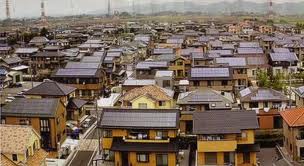After spending much of the first part of the year preparing modest outlooks for the global solar PV industry, analysts are now busy upgrading their forecasts as the world’s biggest economies show increased demand for the technology.
Deutsche Bank is the latest to upgrade its forecasts – for the second time in as many months – predicting that the 2014 global solar market could jump to 45GW, after rising to 38-40GW in 2013.
In a preview to the Intersolar conference in San Francisco this week, Deutsche bases its forecasts on strong demand from “sustainable” markets such as Japan, US, India and China, the acceleration in demand from emerging markets such as Chile, the Middle East and South East Asia, and stabilising demand from Europe.
Deutsche’s analysis is more bullish than an NPD Solarbuzz report last week that forecast solar PV demand for calendar 2013 to reach a record high of 35.1GW, after a strong second half that would result in 20GW being installed. In March, research group predicted full year demand of just 31GW.
NPD Solarbuzz analyst Michael Barker said the market was still in transition (from older markets such as Europe to newer ones in Asia), and would continue to rely on four key countries for the bulk of demand – Germany, China, Japan, and the US – which accounted for more than 60 per cent of demand in the first half.
It said China and Japan alone would account for 45 per cent of global demand in the second half, up from just 10 per cent three years ago.
“In 2013, the number of large-scale PV projects completed in these two countries alone will determine the level of annual growth from the industry, and by how much global demand can exceed the 35 GW mark,” Barker said.
NPD Solarbuzz noted that nearly half of the demand in the first half came from large-scale utility and commercial ground-mount applications, with just 20 per cent from residential rooftops (which accounts for nearly 90 per cent of Australian installations). The rest came from non-residential rooftop installations – such as businesses – and off-grid applications.
Deutsche, meanwhile, says the supply situation is also improving as several second and third tier module suppliers in China are facing a credit crunch and will likely wind down their operations.
Tier 1 solar companies are now enjoying a rebound in margins, with prices for modules jumping more than 10 per cent from early February from 60c-63c/watt to 71c-73c/W. Even though the “street price”, code for cheaper modules in the mass market, remain around 60c/W.
Deutsche said this will push margins for some companies from the low single digits in the first quarter to the high single digits or even as high as the mid teens in the second half of the year, and allow Chinese firms to post positive earnings per share results for the first time in 8 to 10 quarters.
“Furthermore, we expect investor sentiment to improve as policy overhangs decrease and there is greater evidence of sustainability of some of these growth drivers,” it said.











